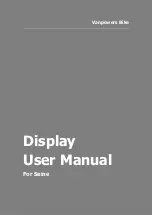
6. INSTALLING THE BATTERY CHARGER
CHOOSING THE MOUNTING LOCATION:
For optimum performance, the charger should be mounted flush on a bulkhead in a protected area away from rain or spray. Do not mount the
charger above batteries as lead-acid batteries give off corrosive gasses which will damage the charger over time. Never allow battery acid to
drip on charger when reading electrolyte specific gravity or filling battery. Also, as with most electrical devices, do not mount the charger below
the waterline of the boat or directly adjacent to fuel tanks.
Each DC output cord is six feet long. Make sure that all DC output cords can reach the batteries and that the AC power cord can reach a power
source. When using an extension cord, make the AC connection to the charger outside of the battery compartment as far away as practical to
reduce the risk of a spark igniting gasses in the compartment.
Each output cord is equipped with a temperature sensor. By monitoring external temperature, the battery charger adjusts the charging profile of
the battery to assure full charge without overcharging or undercharging the battery. Attempting to lengthen or shorten the output wires could
damage the temperature sensor and affect the charger output.
If the DC battery leads are not long enough, they may be lengthened by splicing and soldering 12 AWG (minimum) wire. Each splice should be
covered with dual wall adhesive lined heat shrink tubing to protect the joint from corroding. The splice should be made between the fork in the
output cable and the fuse holder. The fuse holder should always remain within 7” of the battery terminals. The maximum extension length is 15
feet. You may contact the Minn Kota Service Department with any questions. Do not splice the AC power cord, as this voids the three year
Limited Warranty.
Even though the Minn Kota charger is capable of operating in a high ambient temperature environment, a minimum of six inches of unobstructed
area should be allowed on all sides of the unit for proper air circulation and cooling. Proper cooling and circulation will allow the charger to oper-
ate at peak efficiency.
MOUNTING THE CHARGER:
Due to the weight of the charger and the pounding that boats routinely endure, take the time to securely mount the charger to prevent damage.
Mounting with nuts, bolts and washers is preferable to mounting with screws. Use the largest diameter bolts possible
The Minn Kota charger is provided with 4 keyhole slots and 4 permanent mounting holes. The keyhole slots may be used as a temporary
means of holding the charger to mark the locations of the permanent mounting holes. After marking the locations, set the charger aside and drill
the holes. Apply a marine grade silicone sealant in each of the drilled holes to create a waterproof seal. Then secure the charger in place using
the mounting hardware.
Your battery charger is supplied with an AC plug holder designed to hold the power cord plug when not in use. Mount the AC plug holder with
four screws in a convenient dry site to prevent corrosion to the AC plug and to prevent the AC plug from making contact with the battery posts.
CONNECTING THE BATTERIES TO THE CHARGER:
FOLLOW THESE STEPS WHEN THE BATTERY CHARGER IS
INSTALLED IN A BOAT OR VEHICLE
. A SPARK NEAR THE BATTERY MAY
CAUSE BATTERY EXPLOSION. TO REDUCE THE RISK OF A SPARK NEAR THE BATTERY:
1.
Position AC and DC cords to reduce risk of damage by hood, door, or moving engine parts.
2.
Stay clear of fan blades, belts, pulleys and other parts that can cause injury to persons.
3.
Check polarity of battery posts. POSITIVE (POS, P, +) battery post is usually larger in diameter than NEGATIVE (NEG, N, -) post.
4.
Determine which post of the battery is grounded (connected) to the chassis (if any). If negative post is grounded to the boat hull or chassis
(as in most vehicles), see (5) below. If positive post is grounded to the boat hull or chassis, see (6) below. If neither is grounded, the order in
which the output leads are connected does not matter.
5.
For negative-grounded boat or vehicle, connect POSITIVE (RED) output terminal to POSITIVE (POS, P, +) ungrounded post of battery first.
Then connect NEGATIVE (BLACK) output to NEGATIVE (NEG, N, -) grounded post of battery.
6.
For positive-grounded boat or vehicle, connect NEGATIVE (BLACK) output to NEGATIVE (NEG, N, -) ungrounded post of battery first. Then,
connect POSITIVE (RED) output terminal to POSITIVE (POS, P, +) grounded post of battery.
7.
When disconnecting charger, disconnect AC power cord from electric outlet first.
8.
When disconnecting output terminals from battery posts, always do so in reverse sequence of the connecting procedure while as far away
from battery as practical.
WARNING
– MAKE SURE THE CHARGER IS DISCONNECTED FROM AC POWER BEFORE CONNECTING THE BATTERIES TO THE
OUTPUT CORDS.
CAUTION
- Before making any connections to batteries in a confined space (such as a battery compartment of a boat), open the door or hatch
of the compartment and allow it to air out for 15 minutes. This allows any gasses that have accumulated in the compartment to escape.
4
CAUTION –
Because the body of the battery charger is metallic, do not directly mount the charger to the hull of an aluminum boat. Use a
means of isolation (such as wood or plastic) to prevent the charger body as well as mounting fasteners from coming in contact with the alu-
minum boat structure or hull. Doing so will eliminate any risk of electrolysis that may occur when AC power is connected to the charger.






























